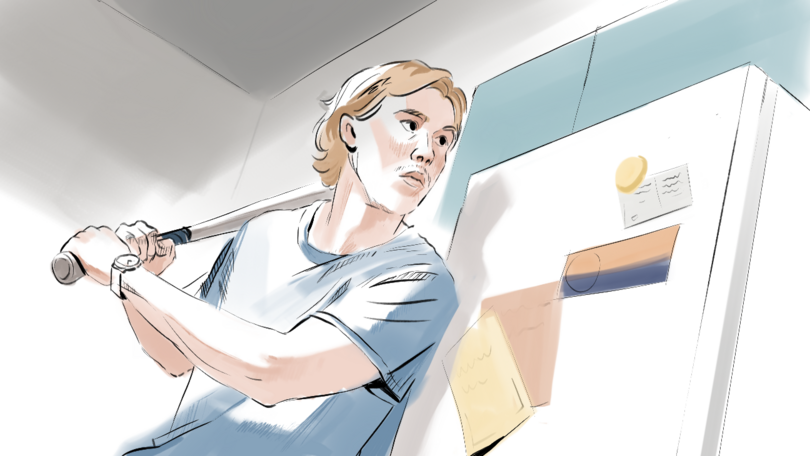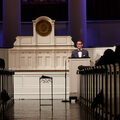‘Caught Stealing’ hits energetic home run in superb medley of thrilling wit

Austin Butler shines in “Caught Stealing.” He delivers a nuanced Hank Thompson, an ex-MLB prospect who gets sucked into New York’s criminal underworld. Julia Rodenberger | Contributing Illustrator
Get the latest Syracuse news delivered right to your inbox.
Subscribe to our newsletter here.
Darren Aronofsky’s “Caught Stealing” feels just like a September MLB game. Each moment feels consequential, actions carry more weight and the stakes are high.
Fueled by a powerhouse performance from Austin Butler, “Caught Stealing” doesn’t take long to ramp up, but when it does, it’s nonstop adrenaline until the end. Set in 1998, “Caught Stealing” follows ex-MLB prospect Hank Thompson (Butler). Over a decade after suffering a career-ending knee injury, he works as a bartender on Manhattan’s Lower East Side.
Though unsatisfying, Hank’s life is relatively normal — until his British, punk neighbor, Russ (Matt Smith), asks him to watch his biting cat, Bud. Two Russian gangsters (Yuri Kolokolnikov and Nikita Kukushkin), who were searching for Russ, attack Hank, leaving him hospitalized and sucking him into New York’s criminal underworld.
A Puerto Rican nightclub owner (Bad Bunny), two Hasidic mobsters (Liev Schreiber and Vincent D’Onofrio) and Detective Roman (Regina King) are also trying to track down the mohawk-sporting Russ.
“Caught Stealing” is an anomaly in Aronofsky’s filmography. Veering away from his usual bleak and disturbing projects, like “Requiem for a Dream” and “Black Swan,” the film finds a sweet balance between wit and thrills. In “Caught Stealing,” the quirks and dark comedy have drawn comparisons to Guy Ritchie’s style and even resemble a Coen brothers-type flick.
Aronofsky, who hails from Brooklyn, is no stranger to films set in the Big Apple. Complemented by Charlie Huston’s screenplay (adapted from his novel of the same name), Aronofsky paints a vivid, grungy portrait of 1990s New York City.
From the opening title sequence — filled with subway tile mosaics and post-punk chords courtesy of IDLES — I was enthralled by the atmosphere, feeling transported to the CBGB club. Between the IDLES’ score and soundtrack including Smash Mouth, Semisonic and Marcy Playground, the music pulls you further into the decade.
Timely visual details complete the setting: a Soundgarden poster in Hank’s apartment, a “DIE YUPPIE SCUM” sticker on Russ’ door and a Shea Stadium scene bring the audience into 1998. My favorite throwback, however, is that Hank and his girlfriend Yvonne (Zoë Kravitz) make fun of Duane’s (Russ and Hank’s neighbor) job: creating websites.
“Caught Stealing” is shot well and contains creative storytelling. One highlight is when Hank is being chased by Hasidic mobsters — Lipa and Shmully — driving a van. In one of Aronofsky’s favorite shots, Butler runs across East Broadway, side-by-side with the vehicle, showing off Hank’s athleticism.
While some have labeled the plot of “Caught Stealing” as too familiar or reminiscent of flicks like Scorsese’s “After Hours,” the story allows the film’s strong suit to shine: the acting.
In arguably his best performance yet, Butler proves his ability to be the next Leonardo DiCaprio or Brad Pitt-esque Hollywood star.
We’ve seen a variety of roles from Butler over the past few years: a crazed Charles Manson follower, Paul Atreides’ gladiatorial antithesis and the iconic Elvis Presley. Somehow, Hank is Butler’s most “normal” character, showing off his acting chops.
Hank deals with nightmarish, traumatic flashbacks, grapples with his lost professional baseball career, manages his relationship with Yvonne and battles ruthless criminals.
Butler delves deep into the character, showcasing incredible emotion and clear character arcs (good and bad). He delivers a nuanced portrayal of the character, both emotionally evolving and unraveling throughout the film.
In a performance filled with charisma, Butler shows a softer side in Hank’s relationship with his mom (Laura Dern). Amid the chaos of a Russian gangster pouncing on people like a rabid dog and Orthodox Jews with silenced pistols, this maternal bond grants adorable sequences of serenity.
After waking up in the hospital, Hank’s first instinct is to call his mom — who’s only heard on the phone until a post-credits cameo — and ask how their beloved San Francisco Giants performed.
Describing Dern as an “angel figure” in his life, Butler’s connection with his on-screen mom extends beyond the picture. In 2014, his own mother, Lori Butler, passed away from cancer. Butler’s mom was often told she looked like Dern, he said to Men’s Health.
Since “Elvis,” Dern has been a mentor and “pseudo-mom” for Butler, guiding him in the creative process and helping him steer away from torturous method acting, Butler said. His other two special bonds in the film are Yvonne and Bud. Though Kravitz meshed well with Butler, her talent is underused. If you’re expecting this to be a Butler and Kravitz movie, it’s not.
However, her absence is redeemed by Bud (played by Tonic the cat). The star feline provides physical reactions to many situations in the film, and he becomes one of Hank’s top priorities by the end.
Stuffed with spectacular performances and a sharp script, this unusually delightful Aronofsky flick proves Butler’s gravitas and sneakily slides in as one of the best movies of the year.






